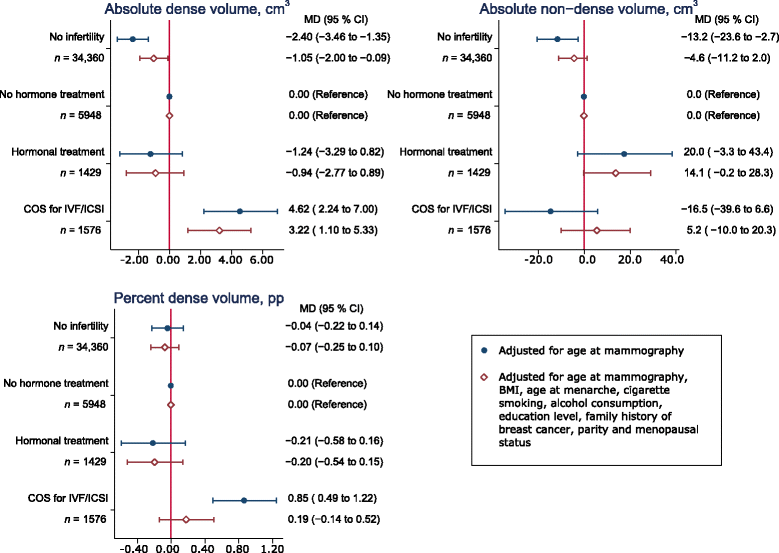Association of infertility and fertility treatment with mammographic density in a large screening-based cohort of women: a cross-sectional study
- PMID: 27072636
- PMCID: PMC4830010
- DOI: 10.1186/s13058-016-0693-5
Association of infertility and fertility treatment with mammographic density in a large screening-based cohort of women: a cross-sectional study
Abstract
Background: Ovarian stimulation drugs, in particular hormonal agents used for controlled ovarian stimulation (COS) required to perform in vitro fertilization, increase estrogen and progesterone levels and have therefore been suspected to influence breast cancer risk. This study aims to investigate whether infertility and hormonal fertility treatment influences mammographic density, a strong hormone-responsive risk factor for breast cancer.
Methods: Cross-sectional study including 43,313 women recruited to the Karolinska Mammography Project between 2010 and 2013. Among women who reported having had infertility, 1576 had gone through COS, 1429 had had hormonal stimulation without COS and 5958 had not received any hormonal fertility treatment. Percent and absolute mammographic densities were obtained using the volumetric method Volpara™. Associations with mammographic density were assessed using multivariable generalized linear models, estimating mean differences (MD) with 95 % confidence intervals (CI).
Results: After multivariable adjustment, women with a history of infertility had 1.53 cm(3) higher absolute dense volume compared to non-infertile women (95 % CI: 0.70 to 2.35). Among infertile women, only those who had gone through COS treatment had a higher absolute dense volume than those who had not received any hormone treatment (adjusted MD 3.22, 95 % CI: 1.10 to 5.33). No clear associations were observed between infertility, fertility treatment and percent volumetric density.
Conclusions: Overall, women reporting infertility had more dense tissue in the breast. The higher absolute dense volume in women treated with COS may indicate a treatment effect, although part of the association might also be due to the underlying infertility. Continued monitoring of cancer risk in infertile women, especially those who undergo COS, is warranted.
Keywords: Gonadotropins; ICSI; IVF; In vitro fertilization; Infertility; Mammographic density; Ovarian stimulation.
Figures

References
-
- National Collaborating Centre for Women's and Children's Health . Fertility: assessment and treatment for people with fertility problems. London: Royal College of Obstetricians and Gynaecologists; 2013. - PubMed
Publication types
MeSH terms
Substances
LinkOut - more resources
Full Text Sources
Other Literature Sources
Medical

